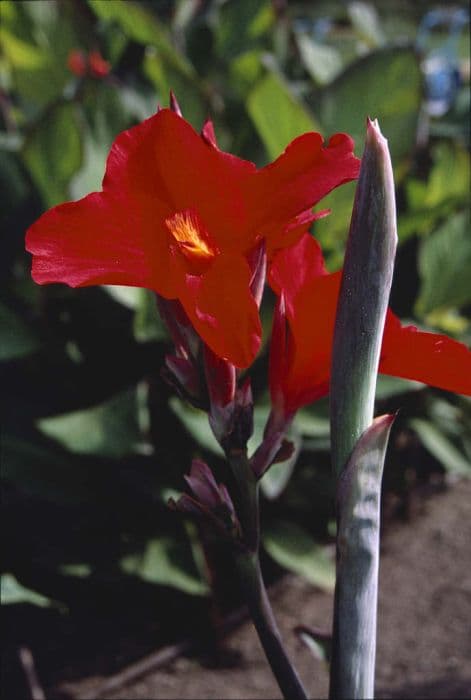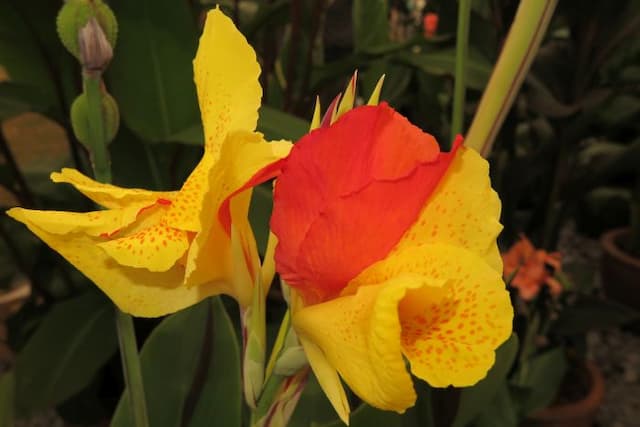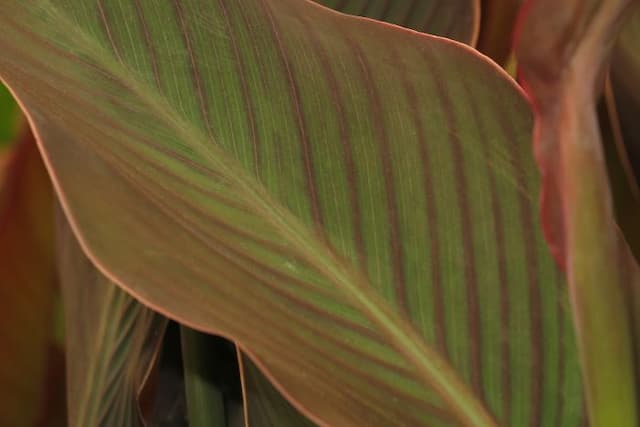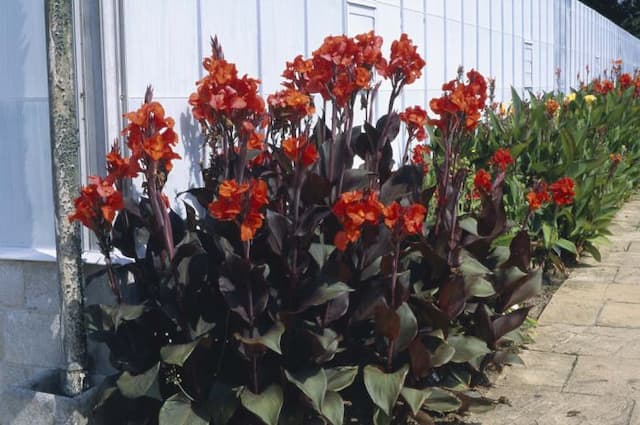Canna Lily Canna × ehemanii
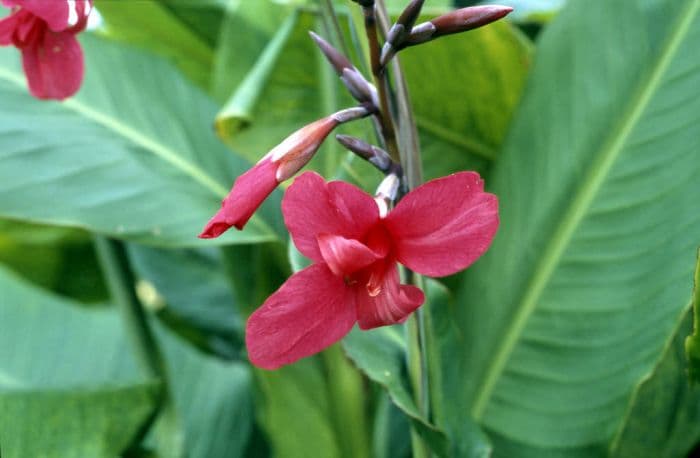
ABOUT
Canna × ehemanii, commonly known as Eheman's canna, is a striking plant that stands out with its lush, green foliage and vibrant flowers. The leaves are broad and paddle-shaped, exuding a tropical ambiance. They can be a deep green or bronzy color, depending on the variety, and they provide a rich backdrop for the flowers. The blooms of the Eheman's canna are its most distinctive feature. These flowers typically appear in shades of vivid red or hot pink and boast an almost iridescent quality. The petals are large and flared, often likened to gladiolus or orchids in shape, and they emerge from the top of tall stems that rise from amongst the foliage. Each flower is made up of several segments that may curl and twist to create a look full of movement and drama. The overall impression of Eheman's canna is one of a lush, vibrant plant that could be a focal point in any garden. Its blooms are attractive to hummingbirds and other pollinators, adding not just color but also a dynamic element to its surroundings.
About this plant
 Names
NamesFamily
Cannaceae
Synonyms
Tropical Canna, Eheman's Canna
Common names
Canna × ehemanii
 Toxicity
ToxicityTo humans
The plant Canna × ehemanii, commonly known as Canna Lily, is not known for being toxic to humans. Thus, in general, it does not pose a risk of poisoning if touched or accidentally ingested in small amounts. However, it is always recommended to use caution and avoid ingesting parts of ornamental plants as they are not intended for consumption.
To pets
For pets, Canna Lily is also not recognized as a toxic plant. The ingestion of the plant typically does not result in serious poisoning in pets such as cats and dogs. However, as with humans, it is good practice to prevent pets from eating ornamental plants since they can sometimes cause mild gastrointestinal upset due to their non-digestible nature.
 Characteristics
CharacteristicsLife cycle
Perennials
Foliage type
Deciduous
Color of leaves
Varies
Flower color
Red
Height
5 feet (1.5 meters)
Spread
3 feet (0.9 meters)
Plant type
Herb
Hardiness zones
8
Native area
Central and South America
Benefits
 General Benefits
General Benefits- Ornamental Value: Canna × ehemanii, commonly known as Canna Lily, is valued for its striking flowers and lush foliage, making it a popular choice for decorative purposes in gardens and landscapes.
- Habitat for Wildlife: The Canna Lily can provide a food source and habitat for beneficial insects, such as bees and butterflies, aiding in pollination and biodiversity.
- Erosion Control: Their root systems can help stabilize soil and prevent erosion along banks of ponds, streams, or in areas with loose soil.
- Low Maintenance: Canna Lilies generally require minimal care once established, making them an easy choice for gardeners with varying levels of expertise.
- Seasonal Interest: They offer seasonal interest from spring until frost with their ongoing blooms and attractive foliage, enhancing the visual appeal of the area they occupy throughout the growing season.
- Tolerance of Wet Conditions: This plant can tolerate wet conditions and can be planted in areas that are too moist for other types of vegetation, expanding landscaping opportunities.
 Medical Properties
Medical PropertiesThis plant is not used for medical purposes.
 Air-purifying Qualities
Air-purifying QualitiesThis plant is not specifically known for air purifying qualities.
 Other Uses
Other Uses- The large banana-like leaves of the Canna Lily can be used as a natural wrapping material for foods during cooking, similar to how banana leaves are used in some tropical cuisines.
- Canna Lily flowers are sometimes used as a colorful garnish for salads and desserts, though they should be used sparingly as they are not known for being particularly flavorful.
- The rhizomes of the Canna Lily, while not edible, can be used in the production of a purple dye for fabrics or paper products.
- Due to their vibrant colors and large size, Canna Lily plants are excellent for creating living privacy screens or hedges in landscaping.
- The dried stalks of the plant can be used as biodegradable garden stakes or to create natural trellises for supporting other plants.
- Canna Lily seeds, which are hard and dense, can be used as beads in jewelry-making or as rattles in musical instruments.
- The sturdy leaves can also be used in crafts or as organic platters for serving dry food items at eco-friendly events.
- In water gardens, Canna Lily plants can be used to provide height and visual interest, as well as to help partially shade the water, which can reduce algae growth.
- The fibrous material from the plant can be processed and used for making handmade paper or incorporated into mixed-media art projects.
- The flowers can be used as a natural colorant to make inks for art or writing, although the process of extraction and stabilization may be complex.
Interesting Facts
 Feng Shui
Feng ShuiThe plant Canna Lily is not used in Feng Shui practice.
 Zodiac Sign Compitability
Zodiac Sign CompitabilityCanna Lily is not used in astrology practice.
 Plant Symbolism
Plant Symbolism- Loveliness and Grace: The Canna Lily, with its large, showy flowers, often symbolizes loveliness and grace, reflecting its elegant form and captivating presence.
- Confidence: The Canna Lily's bold stance and bright colors can signify confidence, making it a symbol for those looking to make a statement or stand out.
- Prosperity and Abundance: In some cultures, Canna Lilies are associated with prosperity and abundance due to their lush and bountiful appearance.
- Change and Transition: Given that Canna Lilies can thrive in various conditions and are often replanted, they may symbolize change or transitioning into a new phase of life.
 Water
WaterCanna Lily (Canna × ehemanii) should be watered thoroughly, allowing the water to soak into the root zone—typically once a week is sufficient. During hot and dry periods, watering frequency may increase to twice a week. You should aim to provide about 1 to 1.5 gallons of water per week, depending on the size of the plant and the weather conditions. Always water at the base of the plant to avoid wetting the foliage, which can promote disease. Reduce watering in the fall as the plant prepares for dormancy.
 Light
LightCanna Lily thrives in full sunlight, needing at least 6 to 8 hours of direct sun daily. The best spot for this plant is an area where it can receive ample morning sunlight and some protection from the intense heat of late afternoon sun. Avoid placing it in full shade as it will not bloom as prolifically.
 Temperature
TemperatureCanna Lily prefers a warm climate and does best in temperatures ranging from 60 to 90 degrees Fahrenheit. It can survive minimum temperatures of about 55 degrees Fahrenheit but should be protected from frost. The ideal growth temperature is between 70 and 85 degrees Fahrenheit. These plants are not hardy in cooler climates and should be lifted or protected in winter if temperatures fall below 55 degrees Fahrenheit.
 Pruning
PruningPruning Canna Lily is essential to encourage more blooms and maintain a tidy appearance. Deadhead spent flowers regularly to promote continuous blooming throughout the season. In late fall, after the first frost, cut the foliage back to a few inches above the ground as the plant goes dormant. Pruning is also the time to divide overgrown clumps, which can be done every few years.
 Cleaning
CleaningAs needed
 Soil
SoilCanna Lily prefers a rich, well-draining soil mix with a pH between 6.0 and 6.5. A good mixture could be equal parts of loam, peat, and sharp sand to ensure proper drainage and fertility.
 Repotting
RepottingCanna Lily should be repotted every 2 to 3 years or when the rhizomes outgrow the pot, typically in late winter or early spring before new growth begins.
 Humidity & Misting
Humidity & MistingCanna Lily thrives in high humidity levels, preferably between 60% and 70%, which is closer to its native tropical conditions.
 Suitable locations
Suitable locationsIndoor
Place in bright, indirect light, keep soil moist.
Outdoor
Plant in full sun, enrich soil, water regularly.
Hardiness zone
8-11 USDA
 Life cycle
Life cycleCanna × ehemanii, commonly known as Eheman's canna, begins its life cycle as a rhizome planted just below the soil surface. In the germination stage, the rhizome develops roots and shoots that emerge from the soil as small green sprouts. The growth stage follows, where the plant produces large, paddle-shaped leaves and elongates its stems, taking weeks to a few months to reach maturity, depending on conditions. Following vegetative growth, it enters the flowering stage, usually in summer or early fall, generating striking red or pink blooms which attract pollinators. After pollination, seeds may form, though many varieties of canna are sterile hybrids and instead propagate through rhizome division. The plant may enter a dormancy stage in response to cooler temperatures or dry seasons, where the above-ground foliage dies back and the rhizome rests until favorable conditions return for the next growing season.
 Propogation
PropogationPropogation time
Spring-Summer
Canna Lily, which includes Canna × ehemanii, is typically propagated through the division of rhizomes, its most popular method. The ideal time to divide and propagate Canna Lilies is in the spring, just as new growth begins. To propagate, gardeners should carefully dig up the clump of rhizomes after the last frost has passed and the soil is warm. Using a sharp knife, they will cut the rhizomes into sections, ensuring each section has at least one eye, or growth point. These sections are then planted directly into the garden or pots, about 3 to 4 inches deep (approximately 7.5 to 10 centimeters) and spaced about 1 to 2 feet apart (30 to 60 centimeters). The soil should be kept moist but not waterlogged to encourage growth. After a few weeks, new shoots should emerge from the soil, indicating that the division has been successful.

